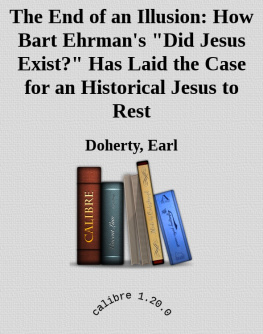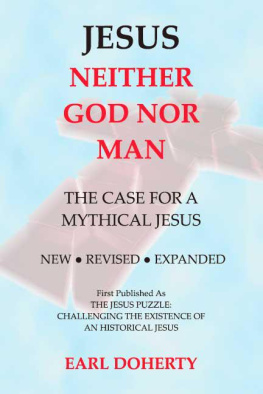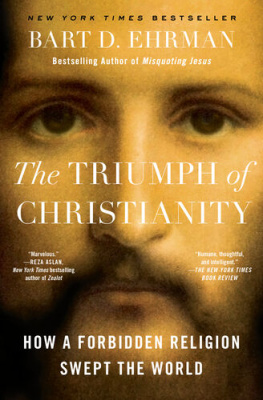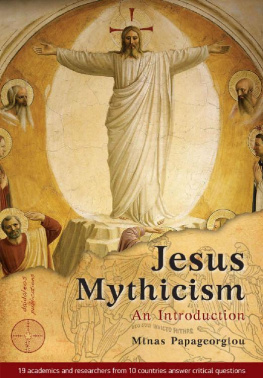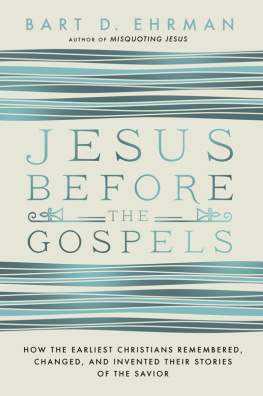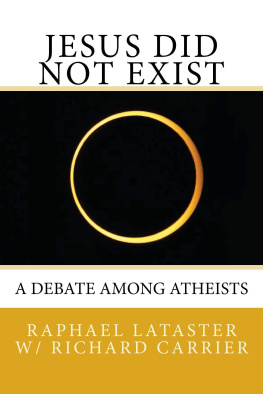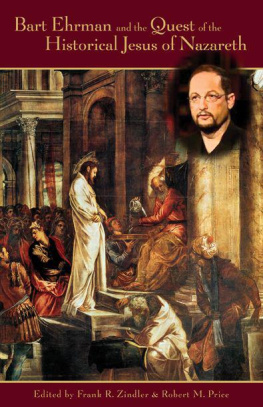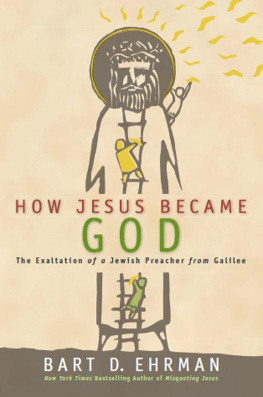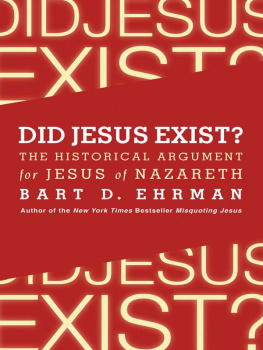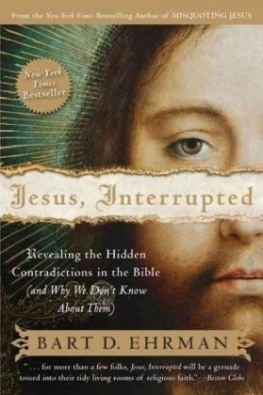Copyright 2012 by Earl Doherty. All rights reserved.
No part of this publication may be reproduced, in any form or by any means, except for review purposes or in a fair use context, without the prior written permission of the author or publisher.
CHAPTER SUMMARIES
________________________________________________________
to the E-book edition
: Introduction
Anticipation of Ehrmans book and initial reaction to it. Procedure in this rebuttal. Ehrmans Introduction: How did a humble non-divine preacher become God? Problems with Ehrmans answer. His recent discovery of mythicism and an appeal to authority. Examining the term myth and a mythical Jesus in the record. Calling on experts. Demonizing agendas.
: An Introduction to the Mythical View of Jesus
Ehrmans appeal to Schweitzer and the problems faced by both Schweitzer and Ehrman. The logical improbability of Ehrmans reconstruction of an historical Jesus. Ehrmans appeal to pre-Gospel sources and his failure to notice the problems that will have for his own reconstruction. Ehrmans treatment of the history of mythicism and the contradiction his observations present for common claims about mythicism among mainstream scholars.
: Basic Mythicist and Historicist Positions
T he argument from silence and the positive case for mythicism . W hy is Paul so silent on the historical Jesus? Pauls words of the Lord . Problematic Gospels and their basis in scripture . Dependence on Mark / no variety in Passion story . The question of parallels with pagan salvation myths . Uncertainty surrounding Jesus teachings.
: Preliminary Remarks
Probability in history and the burden of proof. Ideal evidence historians want against what they actually have. Ehrman downplays the problems with the (lack of) evidence. Unsuccessful comparison with Pontius Pilate. Absence of eyewitness accounts. Late date of the gospels. Ehrman overlooks problems with Lukes Prologue. Ehrman overlooks scholarship on origin of the Gospel of Luke. Ehrman fudges reference to the backbone of New Testament scholarship (Markan priority).
: A Roman Trio
Pliny the Younger Letter to Trajan: Information taken from Christians. Is Christ a man or only a god? Christo quasi deo as or as if? Ancient quotes have no quasi.
Suetonius Life of Claudius:Chrestus and the expulsion of Jews. Misleading translation. Paul and Acts
Tacitus Annals 15 : Christ but no Jesus. Tacitus source: archive or hearsay? Procurator vs. Prefect. The question of authenticity. No Christian witness to martyrdom for the Great Fire. No Roman witness after Tacitus. Sulpicius Severus (c.400) the first witness.
: Jewish Sources
Philo ofAlexandria
Josephus: the Testimonium Flavianum : entirely interpolation or an authentic residue? I s an authentic residue neutral? I s the Testimonium intrusive or a digression? Silence of Christian commentators on the Testimonium before Eusebius. How could Josephus have felt positive or even neutral toward Jesus? I s the Testimoniums language the language of Eusebius? Changes to the Testimonium and its location. The case of the Antiquities 20 reference to brother of Jesus, called Christ.
The Jewish Talmud: Why are there no traditions about Jesus going back to the 1st century?
: Telling the Gospels Like It Is
Should faith documents be treated as legitimate historical sources? Are the Gospels independently based on oral tradition? Matthew and Lukes story is Marks story. Hearing about Nazareth and Jesus. Should we trust accounts of George Washington but not Jesus? Equating Luke and Plutarch, or Luke and Philostratus. Mark as sole source for a life of an earthly Jesus. Luke and Matthews special material (L and M). Johns dependence on the Synoptics. Gospels of Thomas, Peter, Egerton as independent accounts.
: The Existence of Non-Existent Sources
Downplaying what scholarship knows. Oral tradition hypothesis fails the prediction test. How one story became four. Lukes and Matthews special sources. Insupportable claims for Mark and John. Evolution of Jesus. Who invented Jesus?
: Form Criticism and the Sources of the Gospels
The Fallacy of Form Criticism. The Written Evidence of Common Patterns Versus the Oral Tradition Hypothesis. Literary Construction out of Scripture, not Oral Traditions. Traditions in Thomas and Qnot independent. The Path to Jesus is Paved with Good Assumptions. How Ehrman Dates the Sources to the Day After Jesus. The Aramaic Origins of (Some) Oral Traditions. Aramaic originals? An Aramaic Son of Man?
: Listening to the Sounds of Silence
Does anyone on the early Christian scene deny the existence of the Gospel Jesus? Ignatius letters the first to show support for the Gospel story. Does 1 John reveal the first dispute over an historical Jesus? Should we expect Celsus to be a New Testament exegete? Tryphos groundless report. Silent rabbis on Jesus non-existence. Why do 2nd century apologists not attack the Christ cult of Paul as a heresy? The process of transition from a heavenly to earthly Christ. The Logos religion of the 2nd century apologists. Revisiting Josephus and Tacitus .
: Three Voices on the Historical Jesus: No.1 Papias
Papias Exposition of the Sayings of the Lord as revealed by Eusebius. Papias uncertain chain of oral transmission. Had Papias read any Gospels? Papias Mark and Matthew: not the canonical Gospels, and not read by Papias. Papias quotes nothing from any version of our Gospels. The bizarre things Papias gives as sayings of the Lord. By c.125, no written Gospels have reached the bishop of Hieropolis in Asia Minor
: Three Voices on the Historical Jesus: No.2 Ignatius of Antioch
Are the Ignatian letters forgeries? What does truly mean for Ignatius? Ignatius knows no Gospels in 110 CE or later . Rumors of an allegorical tale interpreted as history. No teachings of Jesus, no miracles, no apostolic tradition. Why did docetism arise in Ignatius time? Two reactions to the historical Jesus. A Christ myth in Ignatius Ephesians.
: Three Voices on the Historical Jesus: No.3 1 Clement (with Addendum on the Epistle of Barnabas)
Issue of authenticity of 1 Clement . Does 1 Clement know any Gospels?Christ speaking out of scripture . Clement knows of the Passion through Isaiah 53 . Christs sacrificial blood and flesh belong in the mythical dimension . Prophecy in scripture not fulfilled in history . Epistle of Barnabas: still lacking a written Gospel . Barnabas points to scripture as his source . New Testament math: 0 + 0 = ?A progression from mythical to historical.
: The Non-Pauline Epistles: I
Apostles with no connection to an historical Jesus. Pilate in the 2nd century epistle 1 Timothy . 1 Peter knows a suffering Christ through Isaiah 53. Christ hung on a tree . The flesh and body of Christ and his likeness to men .

